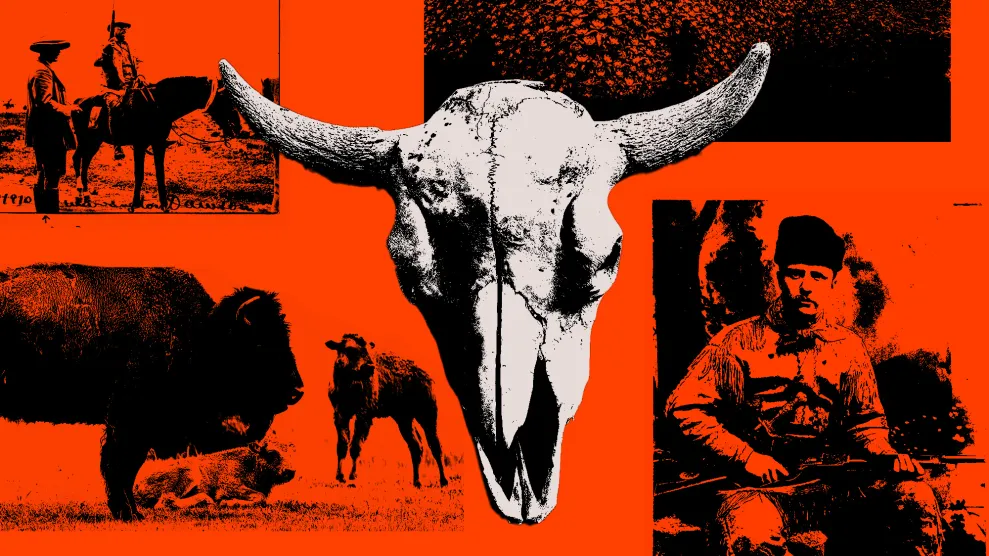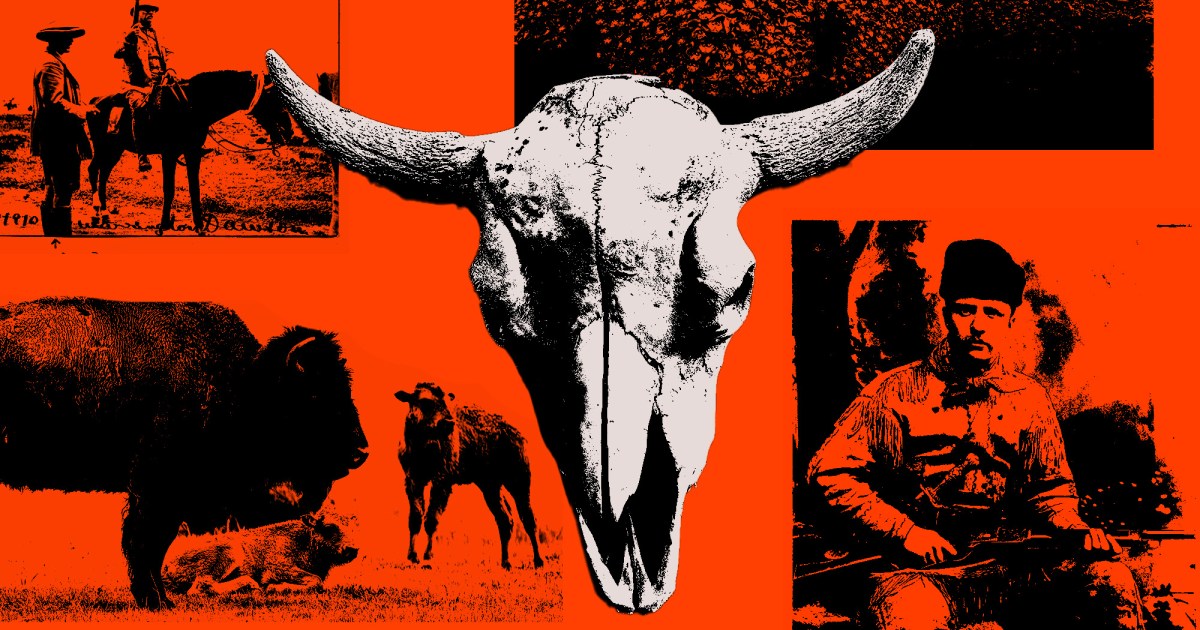
Mom Jones; Library of Congress; Unsplash
In case you attended highschool in the USA, you probably discovered in regards to the “Nice Slaughter” of the American buffalo: In the course of the nineteenth century, with assistance from the railroad, cover hunters poured into the Nice Plains by the hundreds, indiscriminately capturing buffalo (or, technically, “bison”) to gather their furs and tongues, which have been bought as hairbrushes. On the similar time, the US navy actively inspired the hunters within the hope tribes could be extra simply pressured onto reservations with out their meals provide. By the Nineties, hunters had slaughtered so many buffalo that the animals’ numbers, as soon as within the tens of hundreds of thousands, had plummeted to lower than 1,000 people.
The buffalo’s close to extinction, together with the killing of different western mammals like elk and grizzly bears, is “the best homicide of animals within the historical past of humankind,” says American documentary filmmaker Ken Burns. This bleak chapter in American historical past is the main focus of the primary half of Burns’ newest two-part documentary, The American Buffalo, which airs on PBS on October 16 and 17.
At present, there are greater than 400,000 bison within the nation. Whereas most are in business herds, tens of hundreds roam free. On paper, that’s a transparent conservation success. However as half two of Burns’ movie explores, the story of how America saved the species is a heck of much more difficult. As Burns reveals, a collective effort by Native American households, reformed bison hunters, conservationists, and politicians helped deliver the buffalo again—however a few of these concerned had questionable causes for doing so.
William T. Hornaday, as an example, a taxidermist and conservationist, shot and killed a number of the final remaining buffalo so as to put their stuffed skins on show on the Smithsonian, with the hope of inspiring conservation measures. He later went on to assist discovered the Bronx Zoo with Madison Grant, a number one proponent of eugenics and creator of the discredited guide, The Passing of the Nice Race. Hornaday shared lots of Grant’s racist views: “The concept that residents of the USA had pushed this species extinct was offensive to him, was an outrage to him,” science journalist Michelle Nijhuis explains within the movie. “However it was additionally tied up along with his robust sense of racial superiority.”
One other member of the save-the-buffalo membership was showman William “Buffalo Invoice” Cody, who traveled the world depicting “heroic” reenactments of adventures within the American West, together with battles towards Native People. Cody is credited with serving to to deliver the world’s consideration to the bison’s dwindling numbers. However simply years earlier than, he had been among the many hunters liable for decimating the species.

Two males stand with a pile of buffalo skulls in 1892.
After which there’s Theodore Roosevelt, who supported the primary main reintroductions of bison in Oklahoma, South Dakota, and Montana. However Roosevelt additionally as soon as wrote that killing the bison was one thing of a needed evil as a result of it was “the one method of fixing the Indian query”: The buffalo’s disappearance, he wrote, was the “solely methodology” of forcing Native People “to a minimum of partially abandon their savage mode of life.”
These contradictions make the autumn and rise of the buffalo, in Burns’ eyes, a uniquely American story. “It’s each on the coronary heart of the tragedy of the USA,” he instructed me in a dialog final month, “but additionally the chances.”
Burns hopes viewers will see the movie as “the primary two acts of a three-act play,” he says: “The third will likely be written by us, significantly by Native People, who’re working to proceed to develop and restore the nation’s bison herds.” He hopes it could function a “hopeful roadmap” in addressing the mass extinctions the world is dealing with at this time.

Portrait of Theodore Roosevelt, seated, in deer pores and skin searching go well with, holding rifle, 1885.
George Grantham Bain/Library of Congress
You’ll be able to learn an edited and condensed model of my dialog with Burns beneath:
One of the crucial fascinating takeaways out of your docuseries was that largely, now we have dangerous folks—racists—to thank for the survival of the bison. And I used to be like, what do I make of that?
Yeah, so you might have Charlie Goodnight within the panhandle of Texas, who was a Texas Ranger and an Indian-hater who couldn’t stand buffalo. He’s acquired the primary ranch in Palo Duro Canyon, and he begins a buffalo herd for his spouse as a result of she’s 70 miles from the closest neighbor and lonely. And instantly he undergoes this superb transformation: By the top of his life, he’s buddies with Comanche chief Quanah Parker and serving to to reintroduce buffalo.
And even Theodore Roosevelt, now we have to acknowledge, is somebody who had views which are reprehensible. He did consider that the extermination of the buffalo was in all probability good in the long term as a result of it could assist resolve the “American Indian query,” which is cringe-worthy. Then he later goes a protracted technique to save, particularly, the buffalo.
A number of the individuals who helped save the buffalo have been additionally individuals who have been saving it, as journalist Michelle Nijhuis says, “for the unsuitable causes”—to show a type of supremacy. It’s “The White Man’s Burden,” noblesse oblige. That’s—excuse my French—bullshit.
This conservation “success” story additionally appears like a failure to Native People. Whereas white People mobilized to avoid wasting the buffalo, as you word, the identical effort was not prolonged to undo the hurt that the American authorities did to Native People.
That’s the essence of the story. This is in regards to the buffalo, however it’s actually in regards to the US authorities’s remedy of Native People. And it’s scandalous, it’s obscene. It’s a tragedy. For 150 years, many Plains tribes, and for much longer for different Native peoples, had been disconnected from a significant supply of sustenance—they used every little thing from the tail to the snout—but additionally a supply for important spiritual and non secular practices.
Though it wasn’t official coverage of the USA authorities, [officials] thought that “In case you killed the buffalo, you kill the Indian.” They knew the slaughter of the buffalo had an ancillary quote-benefit-unquote, in that it could starve the Native peoples within the Plains and make them extra docile and prepared to be herded into reservations and confined there after which to be Americanized. I imply, the “Mates of the Indian” mentioned, “Kill the Indian, save the person.” They’re those—the progressives—who thought that their tradition needs to be eradicated, their languages and customs needs to be eradicated; that it’s best to place them in colleges and punish them in the event that they spoke their Native languages; dressed them in fits; minimize their hair, an vital image to them. These are the “Mates of the Indian.”
Native People will not be absent from the story of the saving of the buffalo; at one level, many of the [county’s remaining] buffalo have been in captivity in zoos and personal herds. The 2 greatest herds have been run by Native tribes. I feel what is kind of shifting and highly effective in regards to the finish of the story that we inform in our movie is that it’s each hopeful—in that Native peoples are starting to repatriate with the buffalo—however we’re additionally asking, what’s the USA’ complicity and duty on this tragedy?
You don’t make the case for this instantly. However watching it, I felt just like the movie was an oblique name for reparations for Indigenous folks. There’s a quote, as an example, from anthropologist George Chicken Grinnell: “Probably the most shameful chapter of American historical past is that during which is recorded the account of our dealings with the Indians. The story of our authorities’s relations with this race is an unbroken narrative of justice, fraud, and theft.” Did you propose for the movie to really feel like that?
It’s a sophisticated story, and it doesn’t draw back from that. If folks have been to interpret [the film] as saying, these have been sins that we have to atone for, that may be okay with me. However we’re not telling folks—there’s no, What would you want folks to remove from that? It’s a very difficult story about us. And we’re all concerned in it. And it’s a tragedy, and it’s additionally terribly uplifting. The buffalo will not be going to go extinct. It was at risk. There might have been fewer than 25, wild and free, in Yellowstone. Now there are a whole bunch of hundreds in federal fingers, Native fingers, and personal ownerships.
We’re making an attempt to counsel that there’s a Third Act that must be written by all of us. It’s intertwined with our local weather catastrophe. It’s intertwined with our extremely painful historical past. In the beginning of episode two, there’s a [Wallace] Stegner quote: “We’re essentially the most harmful species of life on the planet, and each different species, even the earth itself, has trigger to worry our energy to exterminate. However we’re additionally the one species which, when it chooses to take action, will go to nice effort to avoid wasting what it’d destroy.” And so the query is, are you able to save the buffalo? Are you able to save the planet?
We’re dwelling by means of a local weather disaster and a biodiversity disaster. Is there something to be taught from the bison story to arrange us for this second?
We’re at a second within the historical past of our planet once we might start to see many giant mammals going extinct. The story of the buffalo affords human beings a hopeful roadmap to what it’d appear like to attempt to reverse this. It was a man-made slaughter that diminished the buffalo. We’re in a spot the place what now we have executed to our surroundings, man-made once more, goes to get rid of plenty of large mammals along with hundreds of different species. And we’re obligated, it appears to me, to make use of the story of the buffalo—the errors in addition to the constructive steps—to assist us in our effort to avoid wasting not solely different animals, however our planet and, due to this fact, ourselves.
Would you say the story of the American buffalo is one thing to be ashamed of or celebrated?
There’s a neon signal I put in our modifying room a dozen years in the past that claims in lowercase cursive, It’s difficult, to remind ourselves to at all times dig deep, to incorporate all elements of a narrative. So, let me let me fall again on that—it’s difficult.
I imply, I’ve made the identical movie, over and over. Every movie asks one deceptively easy query: Who’re we? Who’re these unusual and complex individuals who wish to name themselves People? And what does an investigation of the previous inform us about not solely the place we’ve been, however the place are we now? And the place might we be going?
We have now this process, each individually, socially, and nationally, in a broad sense, of being liable for our historical past and making an attempt to be higher, no matter higher is. That’s the entire job. That is the place I function—between the majesty, complexity, contradiction, and controversy of the US and the entire intimacy of the lowercase us. And that’s the place this buffalo story finds itself.



